Blast Alleviation of Sacrificial Cladding with Graded and Uniform Cellular Materials
Abstract
:1. Introduction
2. Theoretical and Numerical Models
2.1. Problem Description
2.2. Stress-Strain Relations of Cellular Materials
3. Blast Alleviation of Graded-Uniform Cellular Sacrificial Claddings
3.1. Positively Graded-Uniform Cellular Sacrificial Cladding (PG-U Cladding)
3.2. Negatively Graded-Uniform Cellular Sacrificial Cladding (NG-U Cladding)
4. Results and Discussion
4.1. Critical Length
4.2. Propagation of Shock Wave in the Cladding
4.3. Parametric Analysis
5. Comparison with Cell-Based Finite Element Model
6. Conclusions
Author Contributions
Funding
Conflicts of Interest
References
- Ashby, M.F.; Evans, T.; Fleck, N.; Gibson, L.J.; Hutchinson, J.W.; Wadley, H.N.G. Metal Foams: A Design Guide; Butterworth-Heinemann: Oxford, UK, 2000; pp. 1–5. [Google Scholar]
- Ding, Y.; Wang, S.; Zhao, K.; Zheng, Z.; Yang, L.; Yu, J. Blast Alleviation of Cellular Sacrificial Cladding: A Nonlinear Plastic Shock Model. Int. J. Appl. Mech. 2016, 8, 1650057. [Google Scholar] [CrossRef]
- Yang, J.; Wang, S.; Ding, Y.; Zheng, Z.; Yu, J. Crashworthiness of graded cellular materials: A design strategy based on a nonlinear plastic shock model. Mater. Sci. Eng. A 2017, 680, 411–420. [Google Scholar] [CrossRef]
- Suethao, S.; Shah, D.U.; Smitthipong, W. Recent Progress in Processing Functionally Graded Polymer Foams. Materials 2020, 13, 4060. [Google Scholar] [CrossRef] [PubMed]
- Hanssen, A.G.; Enstock, L.; Langseth, M. Close-range blast loading of aluminum foam panels. Int. J. Impact Eng. 2002, 27, 593–618. [Google Scholar] [CrossRef]
- Karagiozova, D.; Langdon, G.; Nurick, G. Blast attenuation in Cymat foam core sacrificial claddings. Int. J. Mech. Sci. 2010, 52, 758–776. [Google Scholar] [CrossRef]
- Reid, S.; Peng, C. Dynamic uniaxial crushing of wood. Int. J. Impact Eng. 1997, 19, 531–570. [Google Scholar] [CrossRef]
- Tan, P.J.; Reid, S.R.; Harrigan, J.J.; Zou, Z.; Li, S. Dynamic compressive strength properties of aluminum foams. Part II—’Shock’ theory and comparison with experimental data and numerical models. J. Mech. Phys. Solids 2005, 53, 2206–2230. [Google Scholar] [CrossRef]
- Zheng, Z.; Liu, Y.; Yu, J.; Reid, S.R. Dynamic crushing of cellular materials: Continuum-based wave models for the transitional and shock modes. Int. J. Impact Eng. 2012, 42, 66–79. [Google Scholar] [CrossRef]
- Wang, L.-L.; Yang, L.-M.; Ding, Y.-Y. On the energy conservation and critical velocities for the propagation of a “steady-shock” wave in a bar made of cellular material. Acta Mech. Sin. 2013, 29, 420–428. [Google Scholar] [CrossRef]
- Zheng, Z.; Yu, J.; Wang, C.; Liao, S.; Liu, Y. Dynamic crushing of cellular materials: A unified framework of plastic shock wave models. Int. J. Impact Eng. 2013, 53, 29–43. [Google Scholar] [CrossRef]
- Zheng, Z.; Wang, C.; Yu, J.; Reid, S.R.; Harrigan, J.J. Dynamic stress–strain states for metal foams using a 3D cellular model. J. Mech. Phys. Solids 2014, 72, 93–114. [Google Scholar] [CrossRef]
- Barnes, A.T.; Chandar, K.R.; Kyriakides, S.; Gaitanaros, S. Dynamic crushing of aluminum foams: Part I—Experiments. Int. J. Solids Struct. 2014, 1, 1631–1645. [Google Scholar] [CrossRef] [Green Version]
- Sun, Y.; Li, Q.; McDonald, S.A.; Withers, P.J. Determination of the constitutive relation and critical condition for the shock compression of cellular solids. Mech. Mater. 2016, 99, 26–36. [Google Scholar] [CrossRef] [Green Version]
- Sun, Y.; Li, Q. Dynamic compressive behaviour of cellular materials: A review of phenomenon, mechanism and modelling. Int. J. Impact Eng. 2018, 112, 74–115. [Google Scholar] [CrossRef] [Green Version]
- Zou, Z.; Reid, S.; Tan, P.; Li, S.; Harrigan, J. Dynamic crushing of honeycombs and features of shock fronts. Int. J. Impact Eng. 2009, 36, 165–176. [Google Scholar] [CrossRef]
- Harris, J.; Winter, R.; McShane, G. Impact response of additively manufactured metallic hybrid lattice materials. Int. J. Impact Eng. 2017, 104, 177–191. [Google Scholar] [CrossRef] [Green Version]
- Pang, X.; Du, H. Dynamic characteristics of aluminium foams under impact crushing. Compos. Part B Eng. 2017, 112, 265–277. [Google Scholar] [CrossRef]
- Ma, G.; Ye, Z. Energy absorption of double-layer foam cladding for blast alleviation. Int. J. Impact Eng. 2007, 34, 329–347. [Google Scholar] [CrossRef]
- Liao, S.F.; Zheng, Z.J.; Yu, J.L.; Li, Z.B. A design guide of double-layer cellular claddings for blast alleviation. Int. J. Aerosp. Lightweight Struct. 2013, 3, 109–133. [Google Scholar]
- Karagiozova, D.; Alves, M. Stress waves in layered cellular materials—Dynamic compaction under axial impact. Int. J. Mech. Sci. 2015, 101-102, 196–213. [Google Scholar] [CrossRef]
- Wang, X.; Zheng, Z.; Yu, J. Crashworthiness design of density-graded cellular metals. Theor. Appl. Mech. Lett. 2013, 3, 031001. [Google Scholar] [CrossRef] [Green Version]
- Shen, C.J.; Lu, G.; Yu, T.X. Investigation into the behavior of a graded cellular rod under impact. Int. J. Impact Eng. 2014, 74, 92–106. [Google Scholar] [CrossRef]
- Zheng, J.; Qin, Q.; Wang, T. Impact plastic crushing and design of density-graded cellular materials. Mech. Mater. 2016, 94, 66–78. [Google Scholar] [CrossRef]
- Zhang, J.; Wang, Z.; Zhao, L. Dynamic response of functionally graded cellular materials based on the Voronoi model. Compos. Part B: Eng. 2016, 85, 176–187. [Google Scholar] [CrossRef]
- Liang, M.; Li, X.; Lin, Y.; Zhang, K.; Lu, F. Dynamic Compressive Behaviors of Two-Layer Graded Aluminum Foams under Blast Loading. Materials 2019, 12, 1445. [Google Scholar] [CrossRef] [PubMed] [Green Version]
- He, S.-Y.; Zhang, Y.; Dai, G.; Jiang, J.-Q. Preparation of density-graded aluminum foam. Mater. Sci. Eng. A 2014, 618, 496–499. [Google Scholar] [CrossRef]
- Zhang, Y.; Lu, M.; Sun, G.; Li, G.; Li, Q. On functionally graded composite structures for crashworthiness. Compos. Struct. 2015, 132, 393–405. [Google Scholar] [CrossRef]
- Xu, F.; Zhang, X.; Zhang, H. A review on functionally graded structures and materials for energy absorption. Eng. Struct. 2018, 171, 309–325. [Google Scholar] [CrossRef]
- Zhou, H.; Wang, Y.; Wang, X.; Zhao, Z.; Ma, G. Energy absorption of graded foam subjected to blast: A theoretical approach. Mater. Des. 2015, 84, 351–358. [Google Scholar] [CrossRef]
- Cai, Z.Y.; Ding, Y.Y.; Wang, S.L.; Zheng, Z.J.; Yu, J.L. Anti-blast analysis of graded cellular sacrificial cladding. Explos. Shock Waves 2017, 37, 396–404. (in Chinese). [Google Scholar]
- Nian, W.; Subramaniam, K.V.; Andreopoulos, Y. Dynamic compaction of foam under blast loading considering fluid-structure interaction effects. Int. J. Impact Eng. 2012, 50, 29–39. [Google Scholar] [CrossRef]
- Chen, Y.; Chen, F.; Zhang, W.; Du, Z.; Hua, H. Transient underwater shock response of sacrificed coating with continuous density graded foam core. Compos. Part B: Eng. 2016, 98, 297–307. [Google Scholar] [CrossRef]
- Lan, X.-K.; Feng, S.-S.; Huang, Q.; Zhou, T. Blast response of continuous-density graded cellular material based on the 3D Voronoi model. Def. Technol. 2018, 14, 433–440. [Google Scholar] [CrossRef]
- Aleyaasin, M.; Harrigan, J.J.; Reid, S. Air-blast response of cellular material with a face plate: An analytical–numerical approach. Int. J. Mech. Sci. 2015, 91, 64–70. [Google Scholar] [CrossRef]
- Xiang, X.; Lu, G.; Ma, G.; Li, X.; Shu, D. Blast response of sandwich beams with thin-walled tubes as core. Eng. Struct. 2016, 127, 40–48. [Google Scholar] [CrossRef]
- Ding, Y.; Wang, S.; Zheng, Z.; Yang, L.; Yu, J. Dynamic crushing of cellular materials: A unique dynamic stress–strain state curve. Mech. Mater. 2016, 100, 219–231. [Google Scholar] [CrossRef]
- Karagiozova, D.; Alves, M. Compaction of a double-layered metal foam block impacting a rigid wall. Int. J. Solids Struct. 2014, 51, 2424–2438. [Google Scholar] [CrossRef] [Green Version]
- Wang, L.L. Foundations of Stress Waves; Elsevier: Amsterdam, The Netherlands, 2007; pp. 30–50. [Google Scholar]
- Chen, D.; Kitipornchai, S.; Yang, J. Dynamic response and energy absorption of functionally graded porous structures. Mater. Des. 2018, 140, 473–487. [Google Scholar] [CrossRef] [Green Version]
- Wolcott, M.P. Cellular solids: Structure and properties. Mater. Sci. Eng. A 1990, 123, 282–283. [Google Scholar] [CrossRef]
- Chen, D.; Yang, J.; Kitipornchai, S. Nonlinear vibration and postbuckling of functionally graded graphene reinforced porous nanocomposite beams. Compos. Sci. Technol. 2017, 142, 235–245. [Google Scholar] [CrossRef] [Green Version]
- Koohbor, B.; Kidane, A. Design optimization of continuously and discretely graded foam materials for efficient energy absorption. Mater. Des. 2016, 102, 151–161. [Google Scholar] [CrossRef]
- Liang, M.; Li, Z.; Lu, F.; Li, X. Theoretical and numerical investigation of blast responses of continuous-density graded cellular materials. Compos. Struct. 2017, 164, 170–179. [Google Scholar] [CrossRef]
- Zheng, Z.; Yu, J.; Li, J. Dynamic crushing of 2D cellular structures: A finite element study. Int. J. Impact Eng. 2005, 32, 650–664. [Google Scholar] [CrossRef]
- Zhu, H.; Thorpe, S.; Windle, A. The effect of cell irregularity on the high strain compression of 2D Voronoi honeycombs. Int. J. Solids Struct. 2006, 43, 1061–1078. [Google Scholar] [CrossRef] [Green Version]



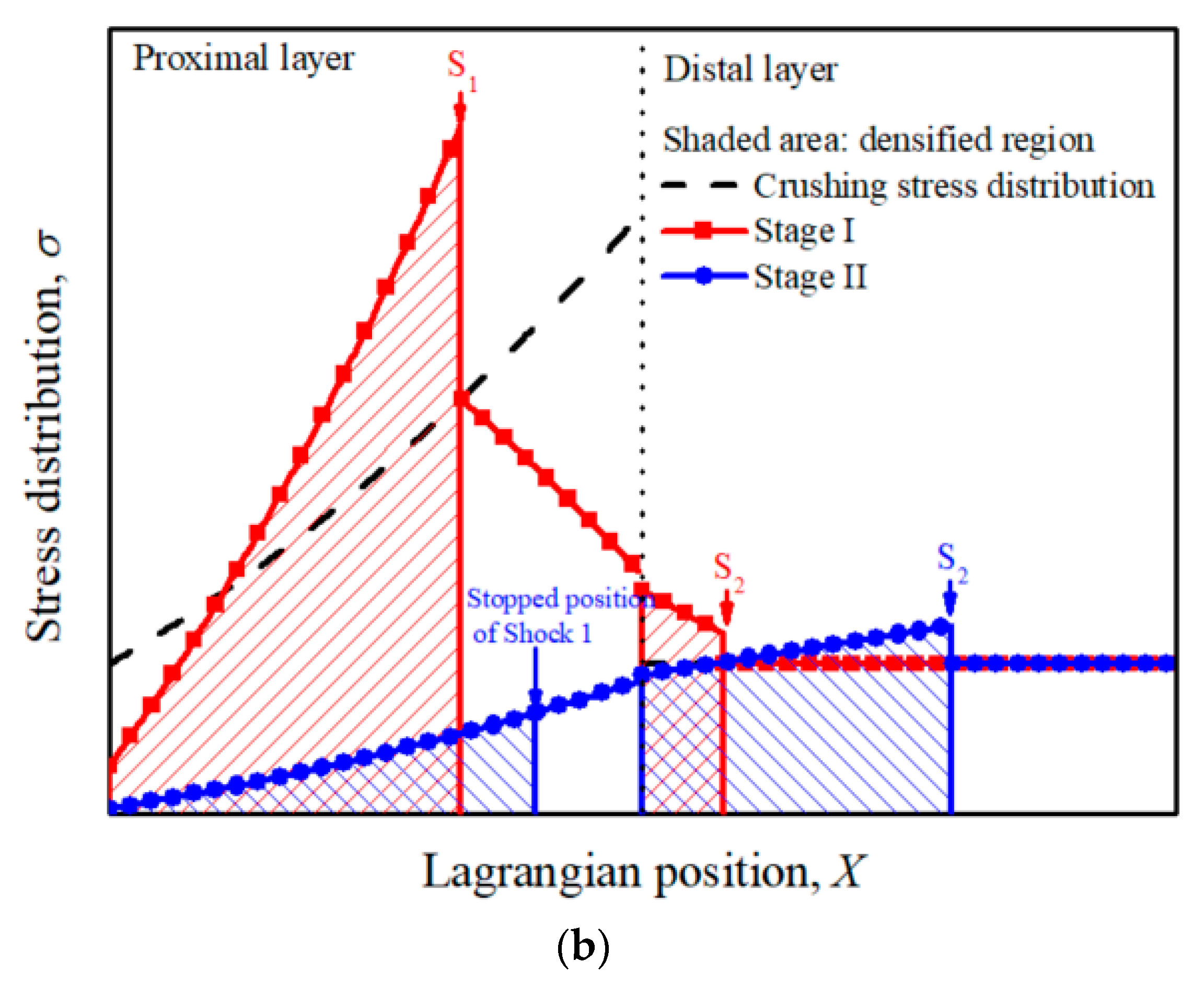
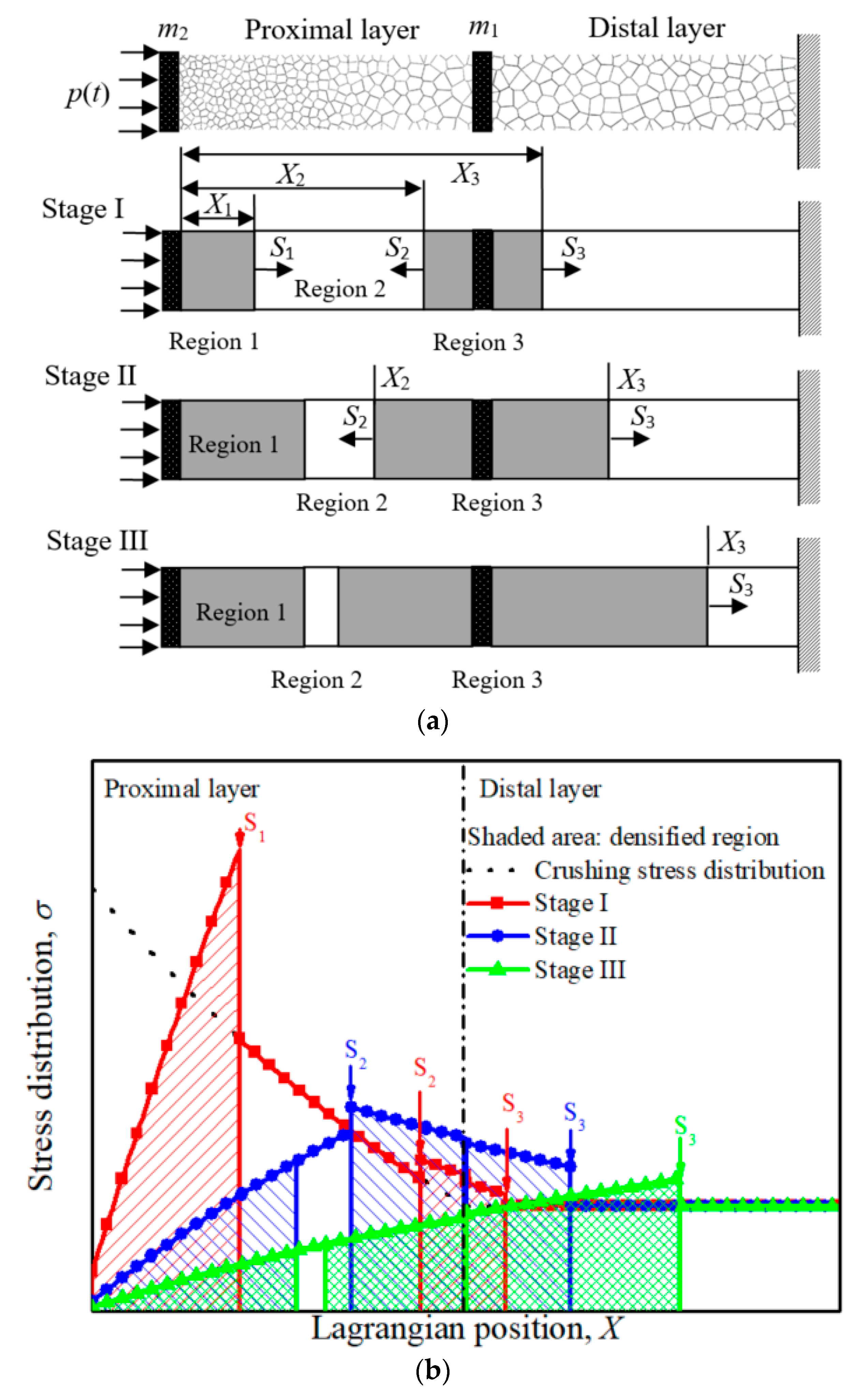
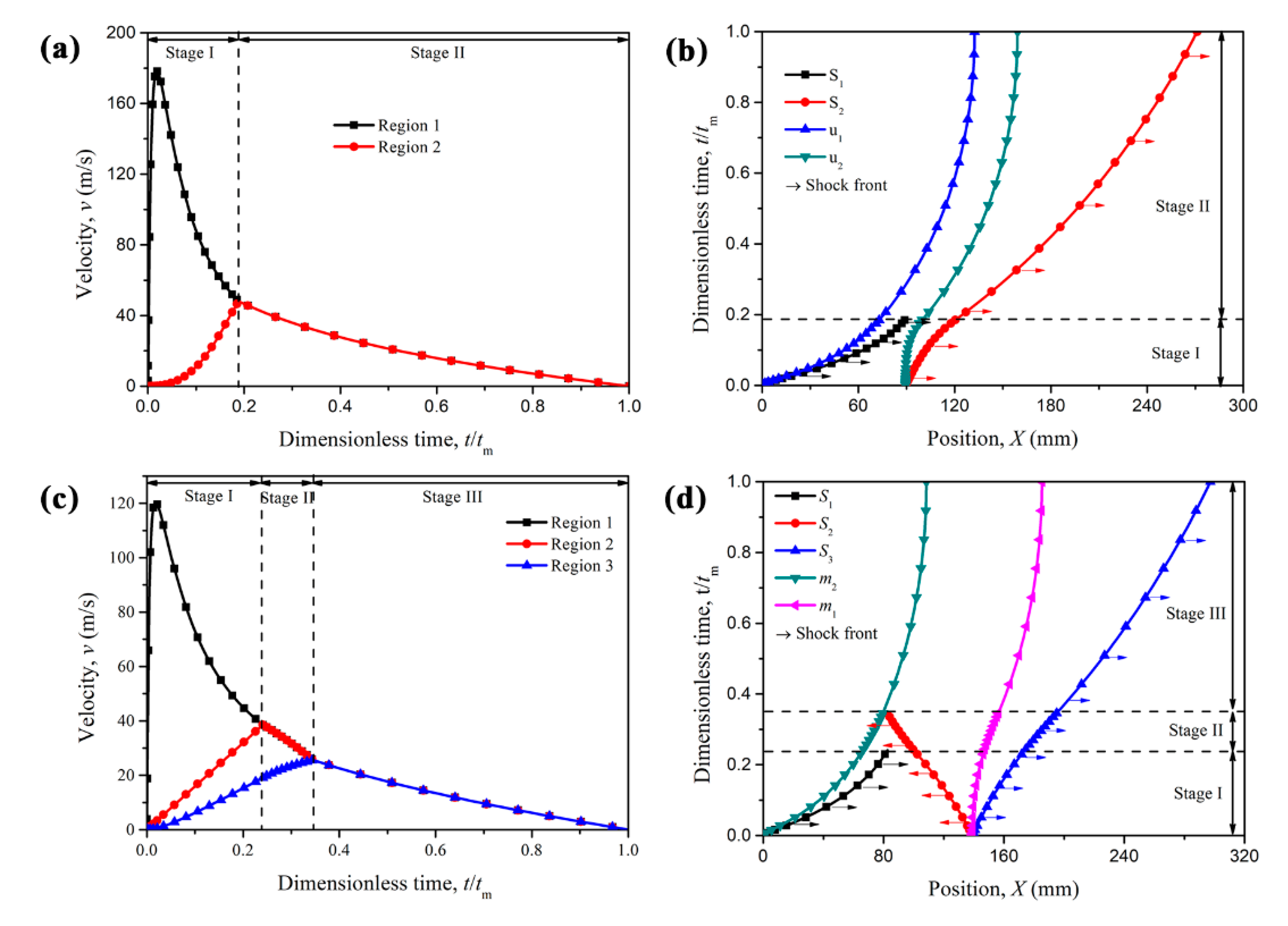

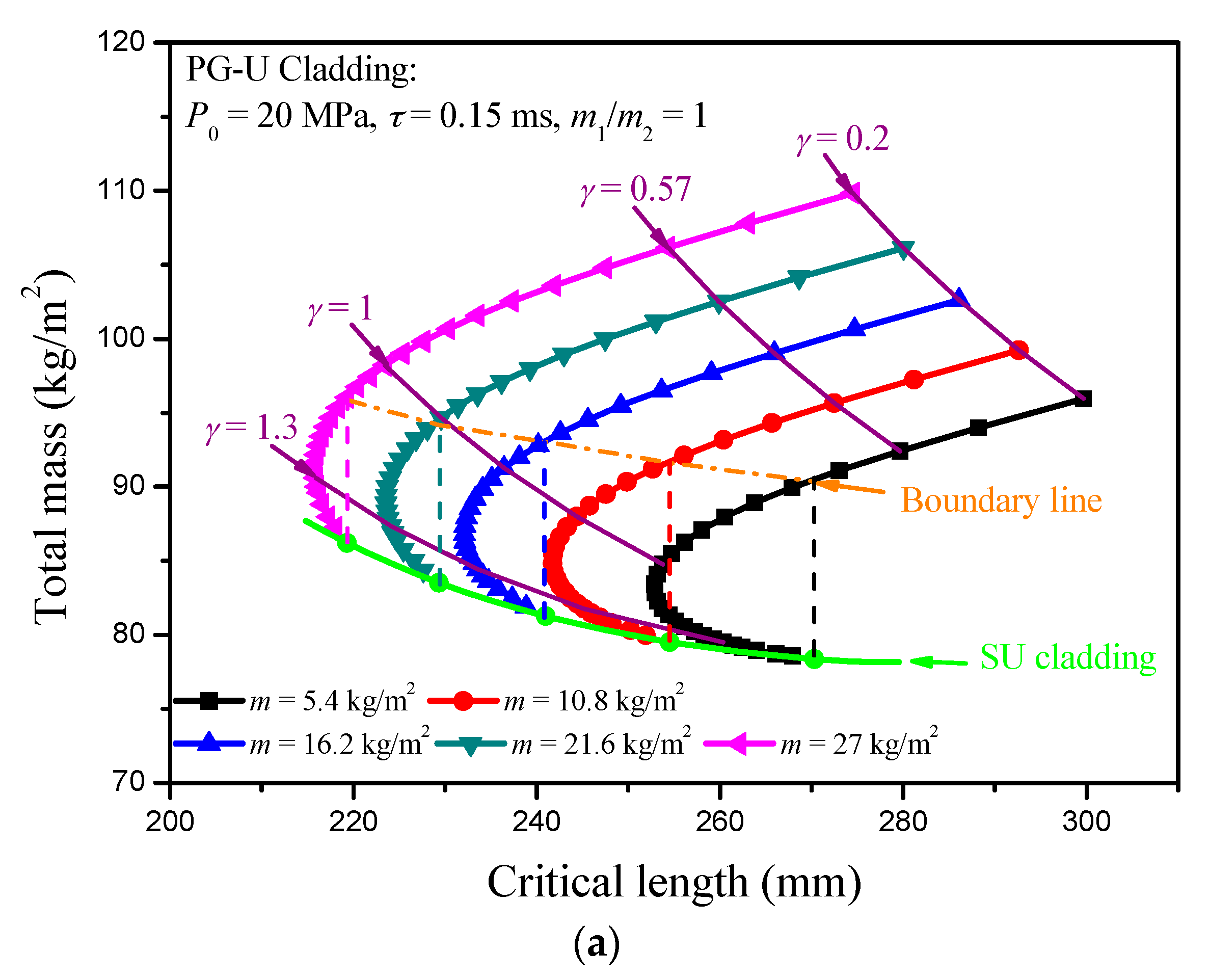
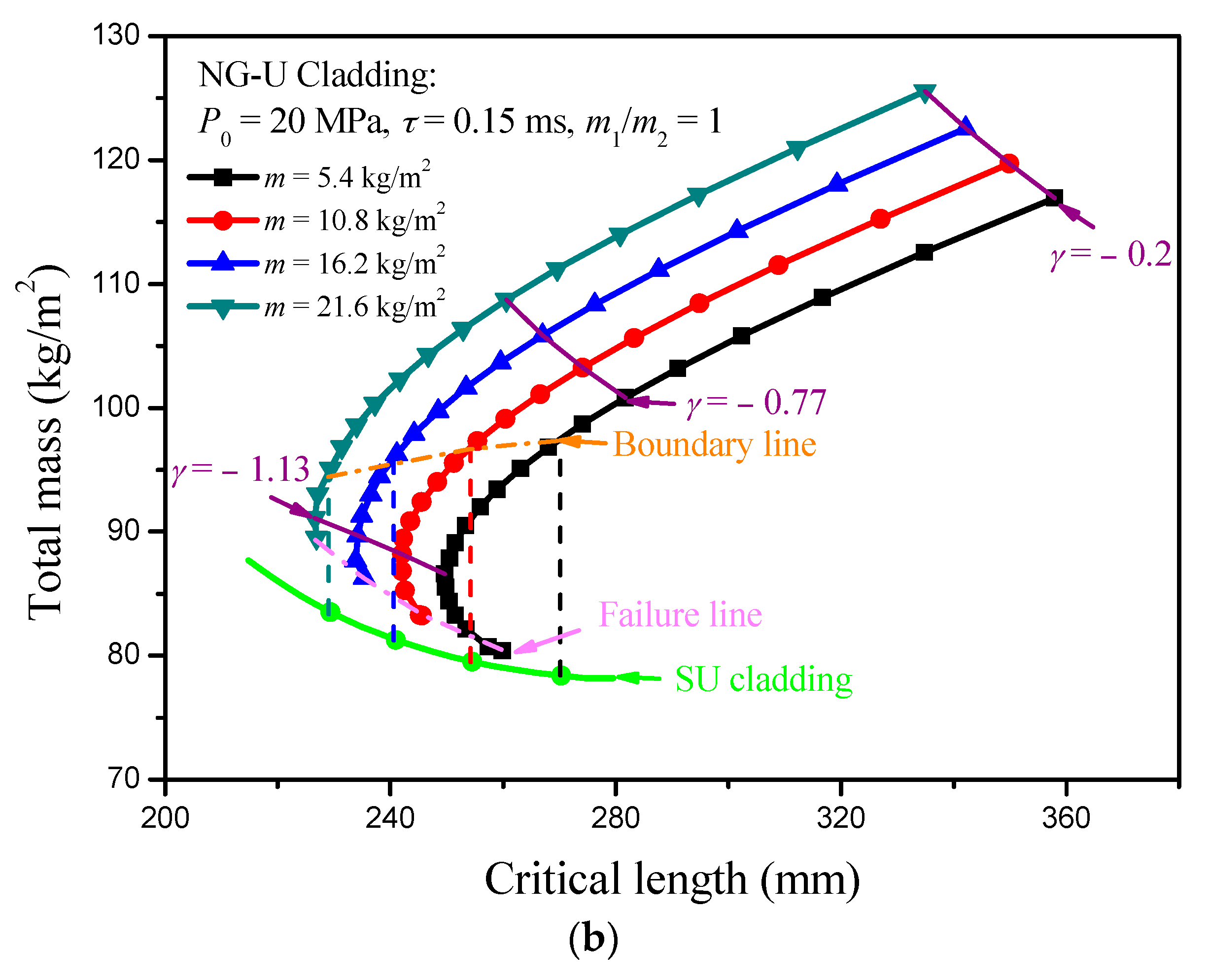
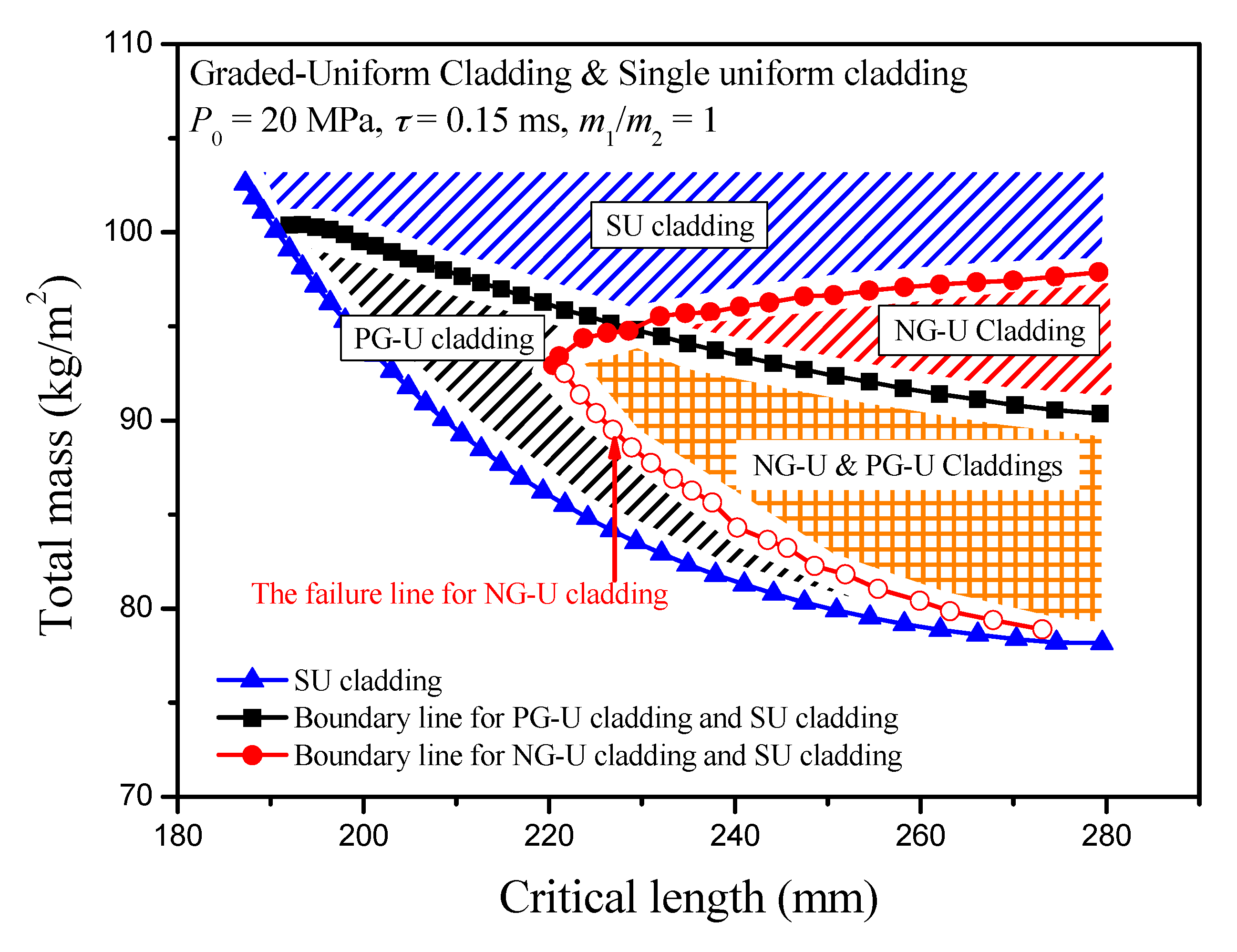

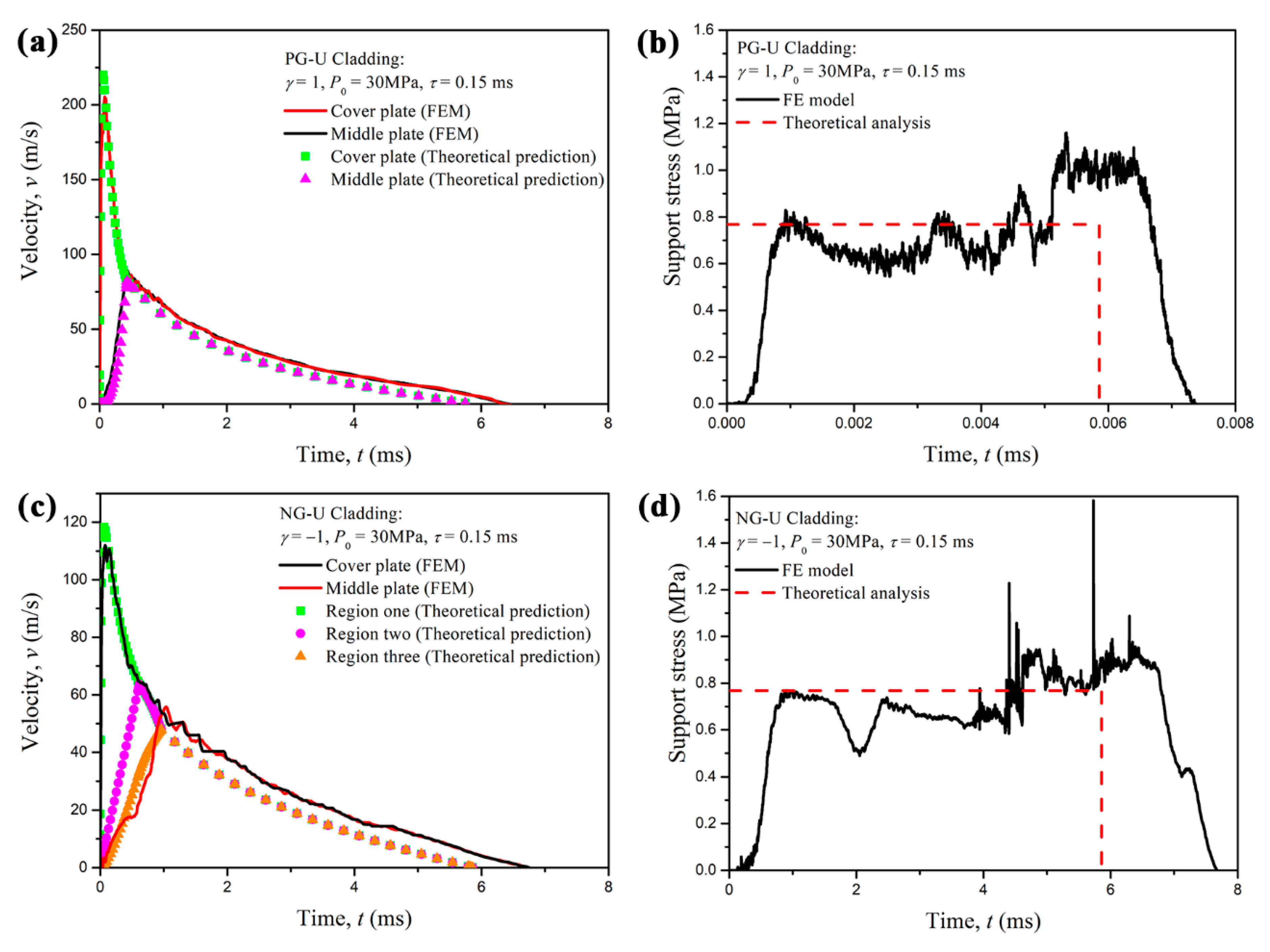
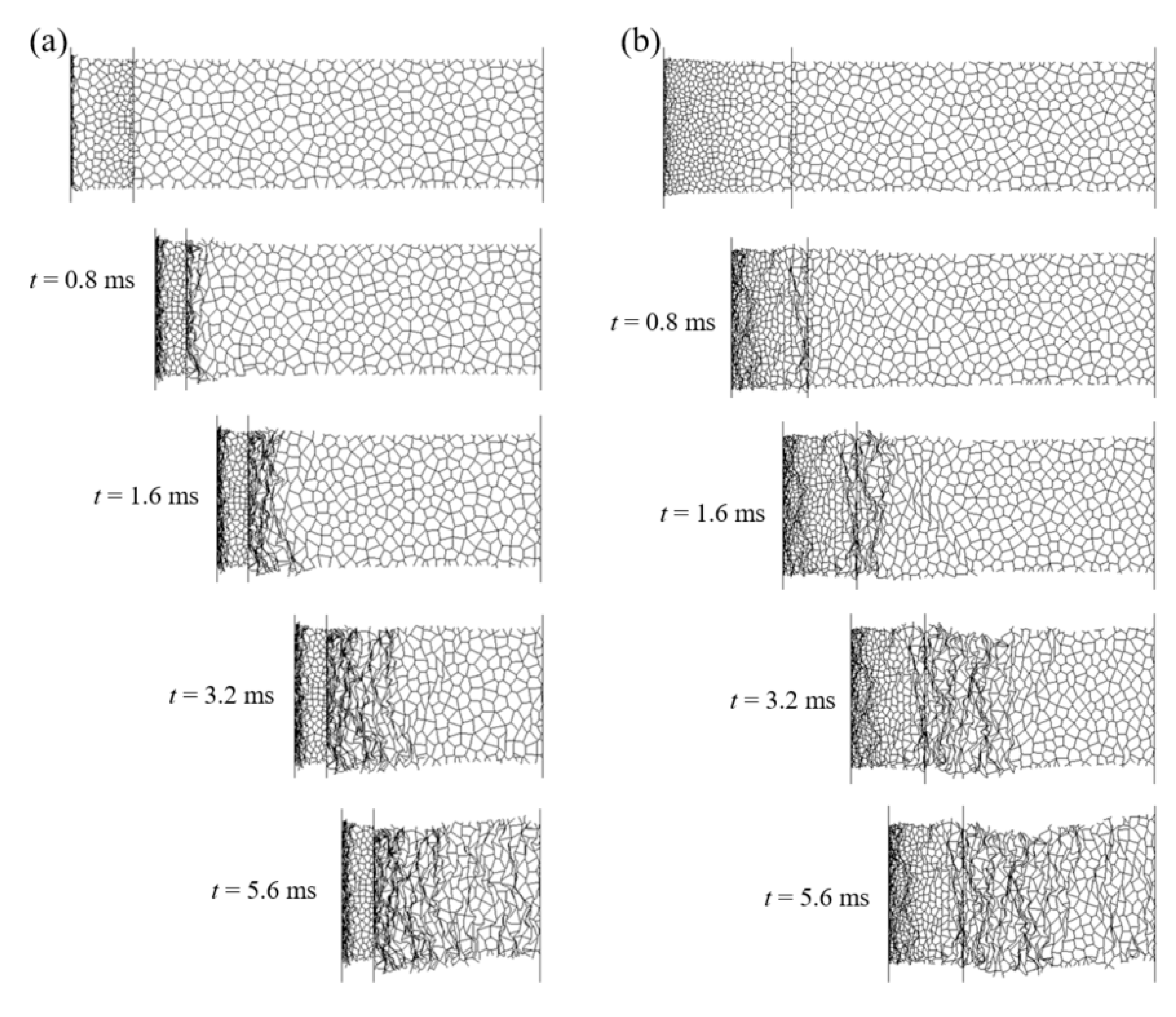
Publisher’s Note: MDPI stays neutral with regard to jurisdictional claims in published maps and institutional affiliations. |
© 2020 by the authors. Licensee MDPI, Basel, Switzerland. This article is an open access article distributed under the terms and conditions of the Creative Commons Attribution (CC BY) license (http://creativecommons.org/licenses/by/4.0/).
Share and Cite
Ding, Y.; Zheng, Y.; Zheng, Z.; Wang, Y.; He, S.; Zhou, F. Blast Alleviation of Sacrificial Cladding with Graded and Uniform Cellular Materials. Materials 2020, 13, 5616. https://doi.org/10.3390/ma13245616
Ding Y, Zheng Y, Zheng Z, Wang Y, He S, Zhou F. Blast Alleviation of Sacrificial Cladding with Graded and Uniform Cellular Materials. Materials. 2020; 13(24):5616. https://doi.org/10.3390/ma13245616
Chicago/Turabian StyleDing, Yuanyuan, Yuxuan Zheng, Zhijun Zheng, Yonggang Wang, Siyuan He, and Fenghua Zhou. 2020. "Blast Alleviation of Sacrificial Cladding with Graded and Uniform Cellular Materials" Materials 13, no. 24: 5616. https://doi.org/10.3390/ma13245616



